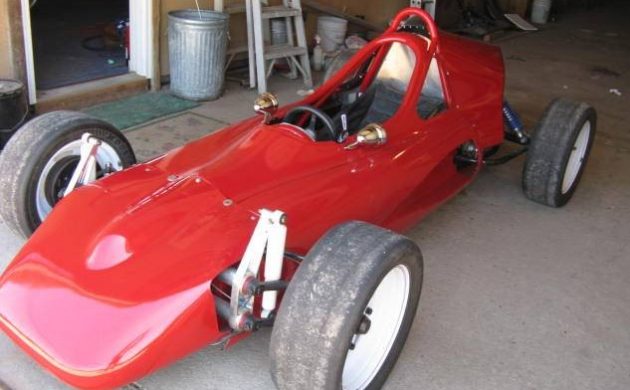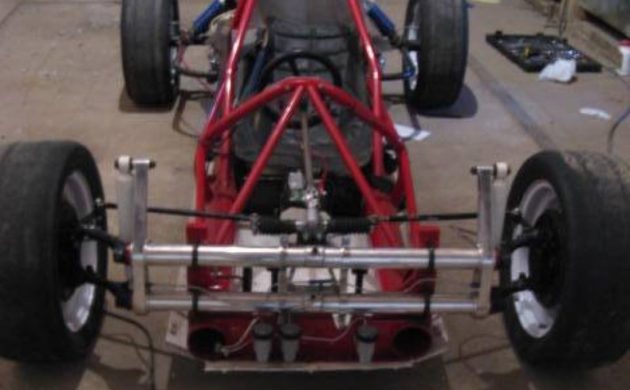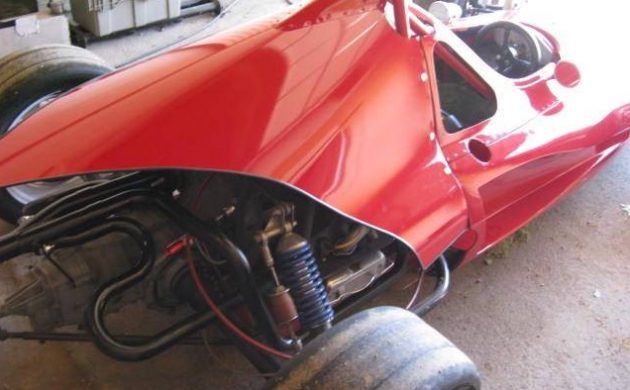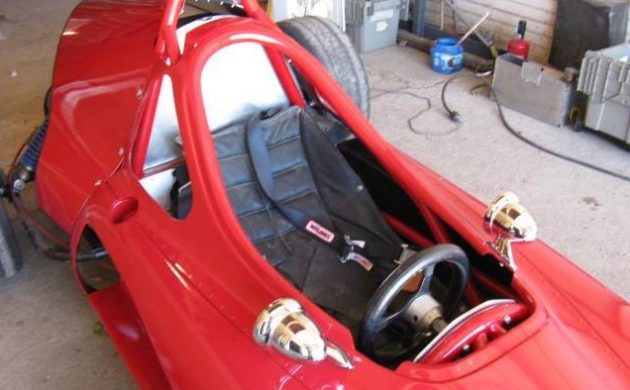Let’s look at something a bit out of the ordinary, how about an open-wheeled race car? No, it’s not a Formula 1 or Indy type, it’s a bit less ambitious than that but it is a very interesting perspective on what can be done with a basic Volkswagen Type I powertrain and front suspension. Unbeknownst to me is this Caldwell FV, it is located in Lincoln, Nebraska, and is available here on craigslist for $5,000. Thanks to Rocco B. for this tip!
The Caldwell “FV” (Formula Vee) Series was the creation of Ray Caldwell’s “Autodynamics” and produced in various versions from 1963 until 1971, totaling about 800 units. Autodynamics was vested in some serious racing creations beyond Volkswagen powered cars, up to and including chassis design for the 1970 SCCA Trans-Am series Dodge Challenger. Caldwell’s earliest VW compatible models were known by the designation D-1 MK1. The seller does not list a model or model year other than to state that this example is from the early ’70s so it is probably a D13 model which were among the last FVs assembled in 1971. Autodynamics continued its existence until 1975 before closing its doors for good.
The seller references no provenance, just that this example has recently been restored with a rebuilt VW 1600 CC, flat, four-cylinder engine (sorry, no image included) and a powder-coated tube frame. The transmission is listed as a manual unit so it is probably a VW four-speed transaxle. It is also listed as having an adjustable suspension.
The seller has nothing more to add and that’s unfortunate because it is hard to get a feel for how this Caldwell was used and how it could best be enjoyed going forward. There is no reference regarding its current operation or potential racing class, just a suggestion that it would be great for SCCA solo. Maybe it would and maybe it wouldn’t, a lot would depend on required safety characteristics and requirements issued by the governing body. It’s certainly not a streetable car and the lack of a title could present a problem in terms of limiting its use for anything other than backyard shenanigans.
Admittedly, the first view of this Caldwell FV conjured up the thought of “What a nice looking go-cart”; it’s obviously quite a bit more than that but what do you do with it? It would be beneficial, and probably valuable, to know this car’s origins, how and where it raced, in what classes, how it did overall and how the current owner came by it. And there may be a story here that the seller will indulge but his stern, “NO JOY RIDES” warning puts this one in the “why bother to ask” category. What do you think, if you were interested, what would you do with this 1970-something, untitled Caldwell FV?





the lack of a log book hurts its value on the vintage racing market – $5K is a lot to ask
A Formula Vee is a fun track day car, or take it to an SCCA drivers school and learn to go racing on a beer budget. The D13 comprised a good portion of any SCCA FV field throughout the 1970s.
I used to do a few hill climbs back in the late seventies and I don’t suppose I ever reached more than about 50 mph but with my backside about 3 inches from the ground it felt like 100 mph. Great stuff but I loaned it to a young friend of mine who promptly sold it to another competitor who “just had to have it.” Seeing as the money I received was about three times what I paid for it I wasn’t too upset. I then tried a McCullough engined go kart, which was fantastically fast in comparison to the VW, but due to the very bumpy tracks I couldn’t keep my foot on the accelerator so quickly sold it on.
Great first entry into vintage racing.
I don’t think it fits into an existing racing class as it sits – it may work as a good autocross car, but not for wheel to wheel racing.
In order to be usable as an actual FV, it’d have to revert to a 1200cc engine and the correct wheels and tires. The big issue is going to be finding a usable engine, good FV engines are getting harder to find (read: more expensive).
Transmission is (or at least should be) a flipped VW Bug transaxle (ie, transaxle behind the engine, not in front).
It is, at best, an overpriced autocross car as it sits. No logbook means it needs to go through a full technical inspection before it can be raced and that means it may need some structural modifications. It will need to go back to a 1200cc engine and a race FV engine can easily top $5k. A set of good 15″x4.5″ stock wheels are generally easy to find. Spec Hoosier tires will be required in SCCA racing. You can generally get a good, proven FV with an SCCA logbook and a few spares for under $7K.
Ray Caldwell/Autodynamics also built Sam Posey’s innovative but ultimately unsuccessful Can-Am car, the Caldwell D7. The design was trying to capitalize on the period’s bias ply tire’s limitations by using a much more rigid suspension, with adjustable wings. As seen here, it was on its second rear wing design, this one non-adjustable.
https://www.conceptcarz.com/vehicle/z11343/caldwell-d-7.aspx
The fv races were always a blast to watch. With everything else being pretty much equal winning often depended on who was willing to get closest to the edge of control😅.
Believe me many folks went right past that edge often
Other than the issues noted above, I’ll add this. The Seller indicates the chassis has been powder-coated. Bad idea. Especially with a race car. Powder-coating will hide the chassis cracks (if there are any) and make welding up what need to be fixed at some point difficult at a minimum.
Sir_Mike – In vintage (pre-73 GCR), the D-13 is the pinnacle of cars to obtain, not a starter. A good starter car is the AutoDynamics Mk3 or 4. Prior to the advent of the D-13, the car to have is a Zink Z-5 (or later known as a Citation-spec C-4). Key aspec of the D-13 is the zero-roll rear suspension.
The 1600 while not legal in a vintage class car can be modified with 1200 barrels and 1200 crank and be legal. If you do it yourself cost you about a grand for the correct P’s&J’s, heads, crank, and cam. “Competitive” intake and carb will set you back about $2,000. The car, while it would not be competitive would be, with a few mods, legal in the SCCA Formula 1st class (modified FV’s).
The asking price is a bit high (but not by much) for the work the car is going to need to put on track as a vintage racer. A good starter (track-ready) car will set you back in the $5-6,000 range. Mid-pack car in the $7-8,000 range and a “front-runner” in the $10,000 area. A D-13 correctly and fully prepped is in that $10k range.
Bill Fleming
68 Zink Z-5 – the chromolly car
My dad was a foreign car mechanic in the 60’s and 70’s. He fixed the car of a young sports car racer who wanted to race Formula V’s at Elkhart Lake. The young man tried to persuade my dad to be his race mechanic, but my dad wasn’t interested in being tied to a racetrack on weekends. The unfortunate young driver died in his first Formula Vee race when he rode up on another car and flipped. All racing has its dangers, even if the cars are not superspeed cars.
Racing is inherently dangerous — to contestants, team support staff, track workers, and spectators. Never forget it.